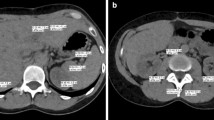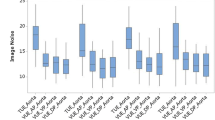Abstract
Objective
To assess the agreement between the true non-contrast (TNC) attenuation values of intra-abdominal structures and attenuation values obtained on virtual-unenhanced (VUE) images based on rapid kVp-switching dual-energy CT. The effects of contrast phase and patient characteristics (e.g., BMI, hematocrit, hemoglobin content) on VUE values were also investigated.
Methods
Ninety four patients who underwent triphasic abdominal CT (liver mass protocol, n = 47; pancreas mass protocol, n = 47) between August 2014 and May 2015 were retrospectively reviewed. Unenhanced series was performed using conventional single-energy mode at 120 kVp. Late arterial and venous phase post-contrast series were obtained utilizing rapid kVp-switching dual-energy CT technique. VUE images were processed off of arterial (VUE-art) and venous (VUE-ven) phase series. Attenuation values of liver, pancreas, kidneys, adrenal glands, muscle, subcutaneous fat, aorta, IVC, and main portal vein were recorded on TNC and VUE sets of images. Attenuation values were compared using univariate linear regression and Student two-tailed paired t test.
Results
There was excellent correlation between TNC, VUE-art, and VUE-ven attenuation values across all organs (p < 0.0001). Paired Student t test, however, showed significant difference between TNC and VUE-art attenuation of kidneys, right adrenal gland, paraspinal muscle, and aorta. There was also significant difference between TNC and VUE-ven attenuation of left kidney. Percentage of cases which had >10 HU difference between VUE and TNC for an individual was calculated which ranged between 13% (right kidney) and 42% (right adrenal gland).
Conclusion
Although the correlation between VUE and TNC attenuation values was excellent and mean difference between TNC and VUE attenuation values was negligible (ranging between −5.94 HU for paraspinal muscles to 6.2 HU in aorta), intra-patient analysis showed a considerable number of cases which had >10 HU difference between VUE and TNC. VUE-ven generally offered a better approximation of TNC values. Further optimization of post-processing algorithms might be necessary before complete replacement of TNC with VUE images.







Similar content being viewed by others
References
Morgan DE (2014) Dual-energy CT of the abdomen. Abdom Imaging 39(1):108–134
Glazer DI, Keshavarzi NR, Maturen KE, et al. (2014) Adrenal incidentaloma triage with single-source (fast-kilovoltage switch) dual-energy CT. AJR Am J Roentgenol 203(2):329–335
Graser A, Johnson TR, Hecht EM, et al. (2009) Dual-energy CT in patients suspected of having renal masses: can virtual nonenhanced images replace true nonenhanced images? Radiology 252(2):433–440
Ho LM, Marin D, Neville AM, et al. (2012) Characterization of adrenal nodules with dual-energy CT: can virtual unenhanced attenuation values replace true unenhanced attenuation values? AJR Am J Roentgenol 198(4):840–845
Kaufmann S, Sauter A, Spira D, et al. (2013) Tin-filter enhanced dual-energy-CT: image quality and accuracy of CT numbers in virtual noncontrast imaging. Acad Radiol 20(5):596–603
Lee HA, Lee YH, Yoon KH, et al. (2016) Comparison of virtual unenhanced images derived from dual-energy CT with true unenhanced images in evaluation of gallstone disease. AJR Am J Roentgenol 206(1):74–80
Sahni VA, Shinagare AB, Silverman SG (2013) Virtual unenhanced CT images acquired from dual-energy CT urography: accuracy of attenuation values and variation with contrast material phase. Clin Radiol 68(3):264–271
Tian SF, Liu AL, Wang HQ, et al. (2015) Virtual non-contrast computer tomography (CT) with spectral CT as an alternative to conventional unenhanced CT in the assessment of gastric cancer. Asian Pac J Cancer Prev 16(6):2521–2526
Wortman JR, Bunch PM, Fulwadhva UP, et al. (2016) Dual-energy CT of incidental findings in the abdomen: can we reduce the need for follow-up imaging? AJR Am J Roentgenol 207:W1–W11
Botsikas D, Triponez F, Boudabbous S, et al. (2014) Incidental adrenal lesions detected on enhanced abdominal dual-energy CT: can the diagnostic workup be shortened by the implementation of virtual unenhanced images? Eur J Radiol 83(10):1746–1751
Mendonca PR, Lamb P, Sahani DV (2014) A flexible method for multi-material decomposition of dual-energy CT images. IEEE Trans Med Imaging 33(1):99–116
De Cecco CN, Muscogiuri G, Schoepf UJ, et al. (2016) Virtual unenhanced imaging of the liver with third-generation dual-source dual-energy CT and advanced modeled iterative reconstruction. Eur J Radiol 85(7):1257–1264
Li Y, Li Y, Jackson A, et al. (2016) Comparison of virtual unenhanced CT images of the abdomen under different iodine flow rates. Abdom Radiol. doi:10.1007/s00261-016-0842-4
Wang W, Liu L, Zeng H, et al. (2016) Utility of virtual unenhanced images and split-bolus injection using spectral multidetector CT for the assessment of renal cell carcinoma conspicuity and radiation dose. Int J Clin Pract 70(Suppl 9B):B56–B63
Miller CM, Gupta RT, Paulson EK, et al. (2011) Effect of organ enhancement and habitus on estimation of unenhanced attenuation at contrast-enhanced dual-energy MDCT: concepts for individualized and organ-specific spectral iodine subtraction strategies. AJR Am J Roentgenol 196(5):W558–W564
Author information
Authors and Affiliations
Corresponding author
Ethics declarations
Funding
No funding was received for this study.
Conflict of interest
The authors declare that they have no conflict of interest.
Ethical approval
All procedures performed in studies involving human participants were in accordance with the ethical standards of the institutional and national research committee and with the 1964 Helsinki Declaration and its later amendments or comparable ethical standards.
Informed consent
Statement of informed consent was not applicable since the manuscript does not contain any patient data.
Rights and permissions
About this article
Cite this article
Borhani, A.A., Kulzer, M., Iranpour, N. et al. Comparison of true unenhanced and virtual unenhanced (VUE) attenuation values in abdominopelvic single-source rapid kilovoltage-switching spectral CT. Abdom Radiol 42, 710–717 (2017). https://doi.org/10.1007/s00261-016-0991-5
Published:
Issue Date:
DOI: https://doi.org/10.1007/s00261-016-0991-5




